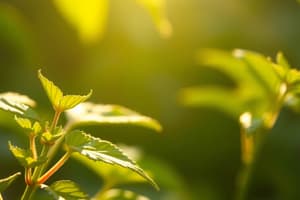Podcast
Questions and Answers
What is the primary purpose of photosynthesis in higher plants?
What is the primary purpose of photosynthesis in higher plants?
- To generate heat energy
- To produce glucose and oxygen (correct)
- To decompose organic matter
- To absorb oxygen from the atmosphere
Which of the following is a key reactant in the photosynthesis process?
Which of the following is a key reactant in the photosynthesis process?
- Nitrogen
- Ammonia
- Hydrogen sulfide
- Carbon dioxide (correct)
In which part of the plant does photosynthesis primarily occur?
In which part of the plant does photosynthesis primarily occur?
- Stems
- Roots
- Flowers
- Leaves (correct)
What role does chlorophyll play in photosynthesis?
What role does chlorophyll play in photosynthesis?
What is produced as a byproduct of photosynthesis?
What is produced as a byproduct of photosynthesis?
Flashcards
Photosynthesis
Photosynthesis
The process used by plants to convert sunlight into energy.
Higher plants
Higher plants
Plants with complex structures, like trees and flowers.
Sunlight
Sunlight
Light from the sun.
Energy
Energy
Signup and view all the flashcards
Conversion
Conversion
Signup and view all the flashcards
Study Notes
Overview of Photosynthesis
- Photosynthesis is the process by which green plants and some other organisms use sunlight to synthesize foods from carbon dioxide and water.
- It's a fundamental process that sustains most life on Earth.
- The overall reaction is 6CO₂ + 6H₂O → C₆H₁₂O₆ + 6O₂.
Light-dependent Reactions
- These reactions occur in the thylakoid membranes of chloroplasts.
- Sunlight is absorbed by chlorophyll and other pigments.
- This absorbed light energy is converted into chemical energy in the form of ATP and NADPH.
- Water is split, releasing oxygen as a byproduct.
- Electron transport chains are crucial in this process.
Light-independent Reactions (Calvin Cycle)
- These reactions occur in the stroma of chloroplasts.
- ATP and NADPH produced in the light-dependent reactions power the Calvin cycle.
- Carbon dioxide from the atmosphere is incorporated into organic molecules.
- This process involves a series of enzymatic reactions.
- The product is glucose, a simple sugar that serves as a primary source of energy.
Factors Affecting Photosynthesis
- Light intensity: Higher light intensity generally increases photosynthetic rate up to a certain point. Beyond this point, further increases don't significantly affect the rate.
- Carbon dioxide concentration: Increasing carbon dioxide concentration usually boosts photosynthetic rate until saturation.
- Temperature: Optimal temperatures exist for photosynthesis. Temperatures outside this ideal range can significantly inhibit the process.
- Water availability: Water is a crucial reactant in photosynthesis. Water shortage leads to reduced photosynthetic rates, as it can impact the production of ATP and NADPH.
Chlorophyll and Pigments
- Chlorophyll a and b are the primary pigments involved in photosynthesis.
- These pigments absorb light energy efficiently, particularly in the red and blue regions of the visible spectrum.
- Accessory pigments like carotenoids absorb other wavelengths of light, expanding the range of light that can trigger photosynthesis.
Photosynthesis and Plant Growth
- Plants use the glucose produced during photosynthesis as a source of energy.
- It's also used for building complex carbohydrates, proteins, and lipids, essential for plant growth and development.
- The production of oxygen is a vital byproduct for most other forms of life on Earth.
C3, C4, and CAM Plants
- C3 plants: These plants are common and have a relatively simple photosynthetic pathway.
- C4 plants: These plants have evolved a more complex photosynthetic mechanism that increases efficiency in hot, dry climates by concentrating CO2.
- CAM plants: These plants open their stomata at night to absorb CO2, minimizing water loss. They carry out the Calvin cycle during the day.
Photosynthesis and Environmental Concerns
- Photosynthesis plays a crucial role in regulating atmospheric carbon dioxide levels.
- Human activities, like deforestation and burning fossil fuels, are increasing atmospheric CO2 levels, disrupting the delicate balance of the carbon cycle.
- Reduced photosynthesis and plant growth can have negative consequences on food security and the overall ecosystem.
Stomata and Photosynthesis
- Stomata are tiny pores on the surface of leaves that regulate gas exchange.
- They allow CO2 to enter and O2 to leave during photosynthesis.
- Guard cells control the opening and closing of stomata, crucial for balancing water loss and CO2 intake.
Studying That Suits You
Use AI to generate personalized quizzes and flashcards to suit your learning preferences.




